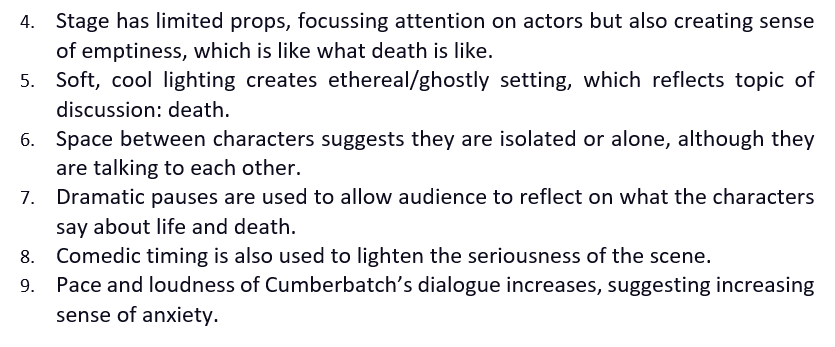Drama students respond to and interpret performances. This can be challenging for students, as performances are inherently multimodal, including a combination of
- movement
- gesture
- sound (music and effects)
- spoken language
- written language
- lighting
- objects.
Joint deconstruction is a collaborative strategy that may be used to make meaning from performances. Joint deconstruction builds skills through discussion, as the teacher leads a shared analysis of performance. In doing so, the teacher can model to students how to consider how different ideas and viewpoints are expressed, and how they might be read and viewed by audiences in multiple ways.
To begin to unpack performances, teachers can ask students a series of questions to focus on different elements of the multimodal text, such as
- What modes of communication does the multimodal text include? (For example, movement, music, spoken word, still projections)
- What information is provided by each of the modes of communication?
- Why do you think colour/sound/movement/positioning has been used in that way?
To jointly deconstruct a multimodal text, such as a performance, the teacher can answer the above questions with the class while viewing and pausing the recording. When doing so, the teacher may also
use think-aloud strategies to show their thinking and reasoning.
Alternatively, teachers can present students with a graphic organiser or table, like the one below, to allow students to note down different modes of communication and their intended effect.

The strategy below is for analysing a recorded performance. If students are to view a live performance, the teacher may provide some context for the performance beforehand, and provide students with a graphic organiser, such as the one above, to take notes whilst viewing the performance.
- The teacher explains that the students are going to watch a scene from a performance.
- The teacher explains the modes of communication that are present in the performance, such as
- movement and gesture
- spoken word
- timing
- lighting
- positioning.
- The teacher distributes a table to assist students to note down their interpretations or understanding of the intended effects of different modes of communication in the performance.
- The students watch the scene once, without taking notes.
- The teacher leads a discussion by asking students what they think the performance is about. Students should be encouraged to reflect on the title of the performance as well as the modes of communication they found.
- The students watch the preview several more times, this time taking notes about the intended effects of the modes of communication used.
- The teacher leads a discussion about how the modes of communication were used in the preview to create meaning or an intended effect. As the students share their analyses, the teacher writes notes on the board.
For example, the below notes were generated by the class after viewing
a recording of Benedict Cumberbatch’s performance of Rosencratz in Tom Stoppard Play.

- The teacher may then use these notes to model
how to write an interpretation response.
Curriculum links for the above example:
VCADRR038,
VCADRR039,
VCADRR045,
VCADRR046.